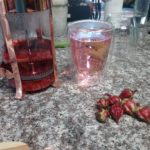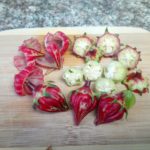 Hibiscus tea is a delicious drink that I look forward to when at home or out on the town during our hot and humid summer months. The drink is a prominent agua fresca accompanying mid-day meal in Mexico and referred to as jamaica or agua de flor, a taste similar to cranberries and enlivened with sugar and ginger, sweet, tart and refreshing. The drink has also regained popularity in current community culture as roselle, lauded for its nutritive content high in calcium, niacin, riboflavin, iron and Vitamin A and C as well as for its appealing deep rose to light pink color and tart, sweet taste.
Hibiscus tea is a delicious drink that I look forward to when at home or out on the town during our hot and humid summer months. The drink is a prominent agua fresca accompanying mid-day meal in Mexico and referred to as jamaica or agua de flor, a taste similar to cranberries and enlivened with sugar and ginger, sweet, tart and refreshing. The drink has also regained popularity in current community culture as roselle, lauded for its nutritive content high in calcium, niacin, riboflavin, iron and Vitamin A and C as well as for its appealing deep rose to light pink color and tart, sweet taste.
Roselle and agua de flor (Hibiscus sabdariffa var. sabdariffa) are hibiscus tea and are a member of the mallow plant family Malvaceae, sharing lineage with plants as diverse as tropical hibiscus and cotton to okra. There are two varieties of H. sabdariffa, one being used for food and the other (H. sabdariffa var. altissima) used for fiber. While roselle’s origin has been theorized from the Sudan, or from India to Malaysia, it has been globally distributed in the tropics and subtropics. Purdue University references an observation of the plant in South American culture in the 17th century, and initial interest from USDA and introduction to the states as a viable commercial crop in Florida in the 1890s. Current concentrated production occurs in China, Sudan and Thailand with major exports to Germany.
This perennial plant is grown as an annual, typically started in late April to May by seed and early harvest beginning in mid-August and potentially lasting until early October. You may be able to successfully cultivate it as a perennial with winter protection, it is sensitive to frost and will not survive a hard freeze. The plant should be grown with full sun exposure in well-draining soil with plenty of organic matter and consistent weekly watering schedule. Pruning at an early stage of vegetative growth will increase branching and promote more flowering shoots.
Th e part we steep to make tea is a bright red and fleshy calyx, which is a collection of single flower parts called sepals that cups or subtends the petals. The calices are harvested a few weeks after the petals have wilted. Keep an eye on the calyx and harvest while still succulent. Separate the ring of connected sepals from around the developing seed pods by cutting off above the pointed leafy green base. You can then steep in boiling water for 15 minutes and use fresh, or dry and store your cultivated roselle to enjoy throughout the year. You can add sweetener such as honey or agave nectar to reduce the tartness, and combine a bit of ginger and lime juice for flavor. Remember to always use sanitary handling practices when preparing and working with raw materials and during the drying and storage process. Contact your county Texas A&M AgriLife Extension Family and Community Health agent for recommendations of best practices related to food preparation and nutrition programs.
e part we steep to make tea is a bright red and fleshy calyx, which is a collection of single flower parts called sepals that cups or subtends the petals. The calices are harvested a few weeks after the petals have wilted. Keep an eye on the calyx and harvest while still succulent. Separate the ring of connected sepals from around the developing seed pods by cutting off above the pointed leafy green base. You can then steep in boiling water for 15 minutes and use fresh, or dry and store your cultivated roselle to enjoy throughout the year. You can add sweetener such as honey or agave nectar to reduce the tartness, and combine a bit of ginger and lime juice for flavor. Remember to always use sanitary handling practices when preparing and working with raw materials and during the drying and storage process. Contact your county Texas A&M AgriLife Extension Family and Community Health agent for recommendations of best practices related to food preparation and nutrition programs.
Here at Brazoria County AgriLife Extension, we continue to explore the beauty and bounty of nature in our own backyard and offer learning experiences from our office. We continue to be your community resource to help improve our quality of life through the Texas A&M AgriLife Extension Service Path to Plate initiative, a program helping consumers understand how their food choices impact their health. Find out more about these programs with links from our county website: brazoria.agrilife.org. I invite you to share your ideas and successes in your garden by browsing online to my Facebook webpage: www.facebook.com/horticulturiststephenb, as well as keeping up with programs and activities promoted from Brazoria County AgriLife Extension. It’s always tea time somewhere in your neck of the coastal prairie, and I’ll see you in the garden.
